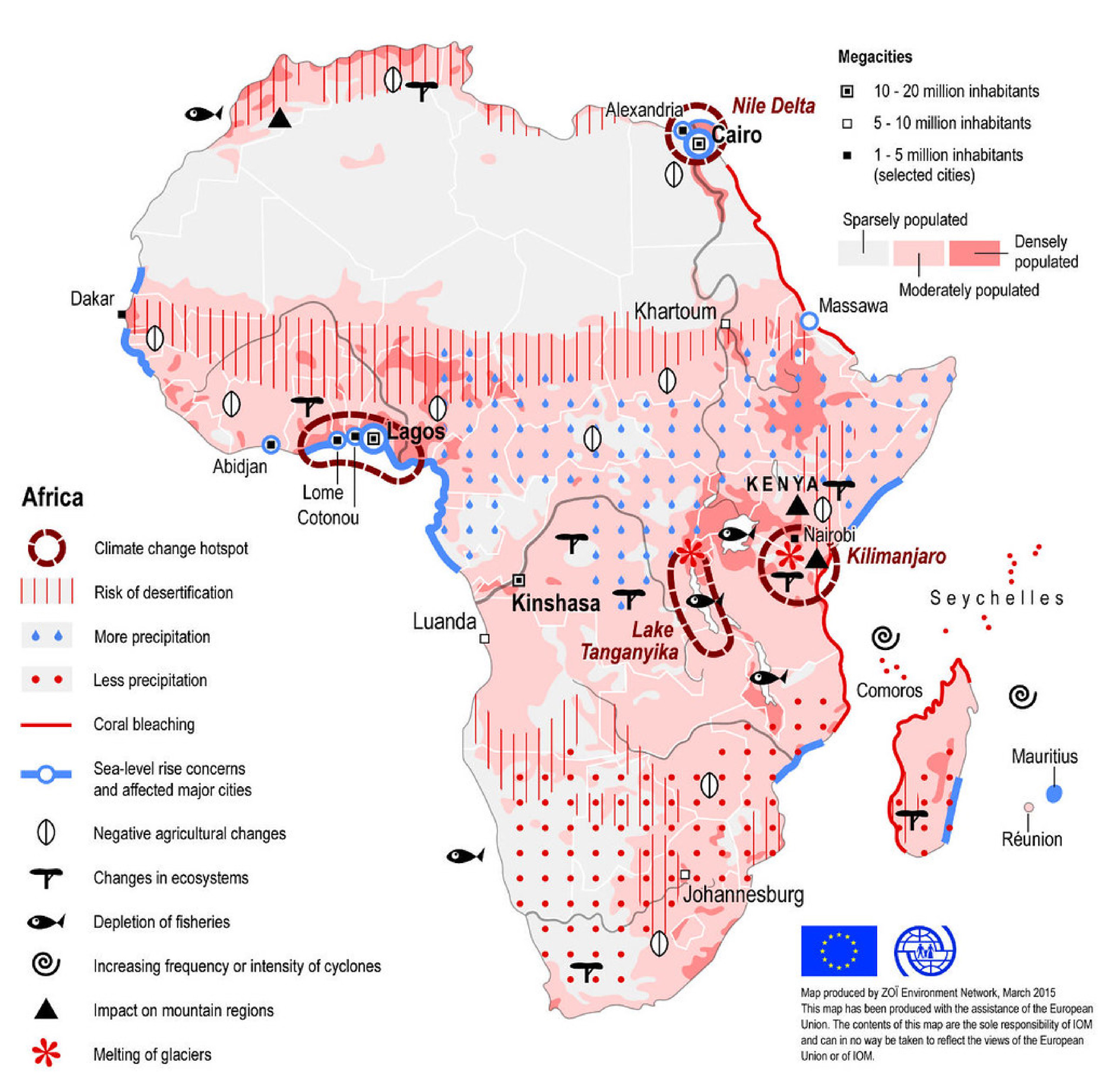The spread of climate disinformation via social media and online platforms is emerging as an impediment to activities that aim to prevent global climate change. This is particularly significant for African nations in view of the continent’s fragile environment and lack of infrastructure to react to dangerous weather events. As social media becomes increasingly popular in Africa, the most popular platforms are becoming the main channels for the spread of disinformation.
With half of the population of Northern and Southern Africa using social media to access daily news (56% in Northern Africa and 45% in Southern Africa), these platforms act as echo chambers where misleading narratives and inaccurate information gain traction, triggering skepticism regarding climate science.
This disinformation casts doubt on climate change and deflects public attention from environmental changes. It also impedes sustainable growth in developing nations by misguiding public perception and delaying the adoption of climate-resilient strategies.
This DevelopmentAid article explores how social media-engineered disinformation is distorting public understanding, impeding green policies, and slowing sustainable climate science in sub-Saharan Africa.
What is climate disinformation?
Climate disinformation is the misrepresentation of scientific facts about climate change and involves the omission or cherry-picking of data on this subject. Disinformation covers the impacts of climate change, downplaying its severity and effect on the environment and communities. It is a large and complex issue as it targets the causes, such as the greenhouse gas (GHG) emissions and the authenticity of climate science itself. It hinders public support for climate interventions by intensifying skepticism and disseminating false narratives about climate science.
Why is sub-Saharan Africa vulnerable?
- High susceptibility to the impacts of climate change: Sub-Saharan Africa now contributes less than 4% of the world’s greenhouse gas emissions, whereas in 2021, it contributed 1.9% with 1.3% coming from South Africa. Despite this minimal contribution, the region faces the extreme effects of climate change. Recent research indicates that the sub-Saharan region could experience a rise in sea levels of almost one meter by the end of this century.
- Increasing use of social media to access news: At least 70% of internet users in nations such as Kenya, Ghana, and Nigeria access information and news through social media platforms. The growing accessibility of social networks increases the exposure of consumers to unverified climate-related narratives.
- Growing green economy and climate actions: Sub-Saharan Africa is predicted to create at least 3 million direct green economy jobs by 2030, with the renewable energy sector accounting for 70% of these.

Source: ResearchGate
Research overview on how social media is fueling climate disinformation
Social media and vested interest industries are leading the broadcast of climate change disinformation in sub-Saharan Africa, according to some researchers. A study by Bruggemann and Engesser in 2017 showed that mainstream and social media often presented a pervasive false balance that enabled opposing scientists to access avenues to spread unchecked information about climate change, which influenced public perception and limited an understanding of the scientific consensus on the topic.
Despite social media platforms promising to mitigate climate disinformation, some popular platforms still allow content that spreads conspiracy theories. For example, researchers of the Global Witness 2022 Report simulated the online activities of climate-skeptic users and found that Facebook’s algorithm recommended climate disinformation content to them.
The African Digital Democracy Observatory report on COP27 showed that climate denialism dominated Twitter – X. Interest in content such as the #ClimateScam narrative surged in July 2022, attracting at least 362,000 mentions comprising retweets from almost 91,000 users. The narrative deceived people by inferring that climate science was a hoax engineered by Western nations to hinder African countries from utilizing their fossil fuel energy sources.
Types of climate disinformation on social media and climate change myths
Social media platforms can be used to allow false narratives and inaccurate information to attract attention and thus give rise to doubts concerning climate science.
Misreporting on climate topics usually takes the form of conspiracy theories, political discourses, climate denial, and ineffective journalism. According to the UNDP report, conspiracy theorists spread mistrust of climate science by stating that climate change is a man-made concept created by governments or global institutions, which then strengthens public resistance to environmental policies.
This was confirmed by a 2024 research paper that found disinformation emanated from political discourses, where varying agendas distorted narratives in favor of specific political ideologies and policies.
In 2023, UNDP underpinned how ineffective coverage and media sensationalism in reporting contributed to myths about climate change which, according to UNDP, include:
- Climate change is a natural process; it has no human influence.
- “Some amount” of warming and higher degrees are not a big deal.
- The increasing number of cold snaps indicate that climate change is a hoax.
By spreading myths through sensationalism, social media is giving equal attention to inaccurate information and unproven scientific facts which skew public perception about climate change and lead to skepticism about its existence.
Impacts of climate disinformation on public perception and sustainable development
Climate disinformation is impacting public perception, community actions, and sustainable development. A 2022 survey by Climate Action Against Disinformation revealed that climate disinformation distorted public knowledge and understanding of climate science. The survey showed that 6% and 23% of the interviewees from the nations involved did not believe in climate change and were uncertain about its occurrence. Uncertainty such as this undermines public support for climate policies and weakens the mandate of government initiatives.
Climate disinformation in the developing world is impacting sustainable growth by deepening social inequalities and hampering inclusive solutions. It shifts political and public attention from the urgent needs of marginalized communities which then deepens disparities in resource accessibility and adaptive strategies.
According to UNDP, by casting doubt on climate science, disinformation hinders the implementation of sustainable solutions that can improve resilience and equity. Misinformation about climate science affects the agricultural sector and delays the adoption of climate-resilient farming thus increasing food insecurity in agriculture-dependent Africa.
This is why addressing and preventing disinformation is important for policy implementation and sustainable growth in Africa.
Key recommendations to address climate disinformation in sub-Saharan Africa
- Use local languages and culturally-based narratives: Native languages make climate science information relatable, helping diverse populations too recognize disinformation on social media. The strategy creates trust and engagement, enabling social media users to evaluate misleading content.
- Use fact-checking platforms to verify information: Platforms play a significant role in ascertaining the validity of information, debunking myths, and offering accurate information to counter misinformation.
- Invest in media and information literacy: Media literacy equips individuals with the ability to identify credible sources, acknowledge misinformation and assess climate-related content.
- Engage messengers and influencers in climate change campaigns: Influencers can counter climate disinformation by sharing accurate and credible content that resonates with their followers. Their extensive reach and credibility can help to spread science-based information and counter false narratives regarding climate change.
Wrap up
Social media is being used to spread false misconceptions that cast doubt on climate science, thereby reducing public trust in green programs and initiatives. Disinformation is rampant in sub-Saharan Africa due to the increasing use of social media platform,s which have little or no regulations. As a result, disinformation is reducing community-level preparedness and delaying the implementation of climate-smart agriculture practices and eroding donor engagement and investments in sustainable climate programs in sub-Saharan Africa.

